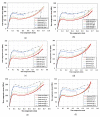Effect of Strain Rate and Silica Filler Content on the Compressive Behavior of RTM6 Epoxy-Based Nanocomposites
- PMID: 34771292
- PMCID: PMC8587845
- DOI: 10.3390/polym13213735
Effect of Strain Rate and Silica Filler Content on the Compressive Behavior of RTM6 Epoxy-Based Nanocomposites
Abstract
The aim of this paper is to investigate the effect of strain rate and filler content on the compressive behavior of the aeronautical grade RTM6 epoxy-based nanocomposites. Silica nanoparticles with different sizes, weight concentrations and surface functionalization were used as fillers. Dynamic mechanical analysis was used to study the glass transition temperature and storage modulus of the nanocomposites. Using quasi-static and split Hopkinson bar tests, strain rates of 0.001 s-1 to 1100 s-1 were imposed. Sample deformation was measured using stereo digital image correlation techniques. Results showed a significant increase in the compressive strength with increasing strain rate. The elastic modulus and Poisson's ratio showed strain rate independency. The addition of silica nanoparticles marginally increased the glass transition temperature of the resin, and improved its storage and elastic moduli and peak yield strength for all filler concentrations. Increasing the weight percentage of the filler slightly improved the peak yield strength. Moreover, the filler's size and surface functionalization did not affect the resin's compressive behavior at different strain rates.
Keywords: epoxy resin; high strain rate; mechanical behavior; nanocomposites; silica nanoparticles; split Hopkinson bar.
Conflict of interest statement
The authors declare no conflict of interest. The funders had no role in the design of the study; in the collection, analyses or interpretation of data, in the writing of the manuscript; or in the decision to publish the results.
Figures














References
-
- Mallick P.K. In: Composites Engineering Handbook. 1st ed. Mallick P.K., editor. CRC Press; Boca Raton, FL, USA: 1997.
-
- Domun N., Hadavinia H., Zhang T., Liaghat G., Vahid S., Spacie C., Paton K.R., Sainsbury T. Improving the fracture toughness properties of epoxy using graphene nanoplatelets at low filler content. Nanocomposites. 2017;3:85–96. doi: 10.1080/20550324.2017.1365414. - DOI
-
- Naik N.K., Pandya K.S., Kavala V.R., Zhang W., Koratkar N.A. Alumina nanoparticle filled epoxy resin: High strain rate compressive behavior. Polym. Eng. Sci. 2014;54:2896–2901. doi: 10.1002/pen.23850. - DOI
-
- Gurusideswar S., Velmurugan R., Gupta N.K. High strain rate sensitivity of epoxy/clay nanocomposites using non-contact strain measurement. Polymer. 2016;86:197–207. doi: 10.1016/j.polymer.2015.12.054. - DOI
Grants and funding
LinkOut - more resources
Full Text Sources

